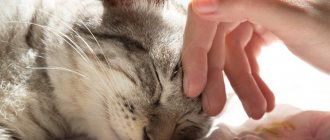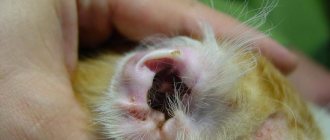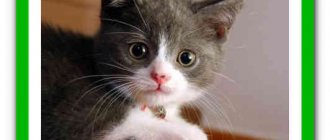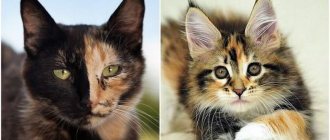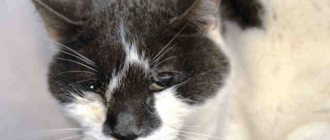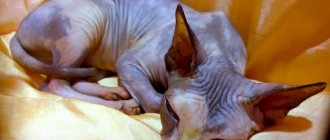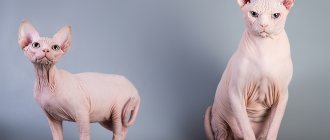Infectious rhinotracheitis in cats (feline herpes) is a dangerous disease of viral origin that affects the eyes and respiratory system. The virus affects cats of all age groups. Cats living in close proximity to infected pets, especially in kennels or shelters, are at greatest risk of contracting the virus.
Feline viral rhinotracheitis is caused by feline herpesvirus 1 (FHV-1) of the Herpesviridae family. It is also called "cat flu" or "feline pneumonia". Rhinotracheitis is not dangerous for humans; our diseases are caused by other viruses of the same family.
Definition of disease
Rhinotracheitis in cats is a common infectious disease caused by the herpes virus. Kittens aged 1.5 to 6 months are most susceptible to the disease. But adults can also easily become ill upon contact with a source of infection.
With timely recognition of the symptoms of rhinotracheitis in cats and proper treatment, recovery occurs in 80-95% of cases. Vaccination is an effective way to prevent the development of pathology.
The disease occurs in acute and chronic forms, in which a long period of remission alternates with bouts of relapse. After recovery, 80% of pets remain carriers of the virus for life.
Important! Often viral rhinotracheitis in cats is complicated by infectious diseases such as chlamydia, mycoplasmosis or calcivirosis. This increases the mortality rate, especially in kittens and pets with weakened immune systems.
Complications of tracheitis
Tracheitis as an independent disease rarely leads to any complications. In this regard, its combined forms are more dangerous. Thus, laryngotracheitis can be complicated by laryngeal stenosis, which is especially typical for young children. With tracheobronchitis, due to spasm and accumulation of a large amount of mucopurulent discharge, some develop obstruction of the respiratory tract.
The spread of the inflammatory process of infectious origin to the lower respiratory organs leads to the development of pneumonia or bronchitis. More often, combined damage to the epithelium of the trachea + bronchi or bronchi, alveoli and interstitial tissue of the lungs is observed, bronchopneumonia or tracheobronchitis is diagnosed.
Malignant or benign endotracheal neoplasms appear as a result of a protracted process of chronic tracheitis, accompanied by morphological changes in the mucosa.
Long-term exposure to allergens on the body in case of impaired sensitization, along with allergic tracheitis, leads to the occurrence of more serious diseases - allergic damage to the bronchi with transition to bronchial asthma, manifested by attacks of suffocation and severe shortness of breath.
Pathogen
The causative agent of infectious feline rhinotracheitis is the herpes virus FHV-1 (Feline Herpes Virus type 1). It is a fairly large DNA-containing enveloped virus. Despite the fact that only the FHV-1 serotype has been isolated in cats, it has different strains that determine the virulence of the pathogen.
Once in the cat’s body, the virus penetrates the mucous membranes of the oral cavity, tonsils, upper respiratory tract and conjunctiva, where it begins to multiply intensively. This gradually leads to the appearance of clinical symptoms of rhinotracheitis.
The stability of this virus in the external environment depends on temperature indicators. It remains viable:
- at +4 °C - up to 5 months;
- from +20 to 25 °C - 18 hours;
- +37 °C – 3 hours;
- +56 °C – 5 min.
The rhinotracheitis virus does not withstand drying and exposure to disinfectants and antiseptics.
Routes of infection
In most cases, the causative agent of rhinotracheitis from infected animals is transmitted to other cats through direct contact. You can also become infected through care items, bedding, toys, trays or dishes.
Much less often, rhinotracheitis is transmitted from sick cats to other cats by airborne droplets. It has been proven that kittens become infected transplacentally from an unvaccinated mother if the cat becomes ill with rhinotracheitis during pregnancy.
Viral rhinotracheitis of cats is not dangerous for humans, dogs and other animals.
Important! Since virus carriers release the pathogen into the external environment during a period of weakened immunity, they pose a potential threat to the health of surrounding cats.
Mechanism of disease development
Once in the cat's body, the causative agent of rhinotracheitis penetrates the mucous membranes of the oral cavity, tonsils, upper respiratory tract and conjunctiva, where it begins to multiply intensively. This gradually leads to necrosis and inflammation of epithelial tissues.
The feline herpes virus also has an affinity for nerve tissues. After penetration into neurons, the pathogen remains in them forever. This explains the formation of lifelong virus carriers in recovered animals.
Important! Cats with a strong immune system do not show clinical symptoms of rhinotracheitis. But at the same time, they become virus carriers and are able to infect other pets.
Causes of rhinotracheitis in cats
Once in the body, the virus can remain latent. The cat feels fine.
The disease is caused by the activity of FHV-1, which is provoked by certain factors:
- Poor nutrition. The pet is fed dry food and raw meat, food from the table. They do not follow the regimen and dosage; this is especially dangerous for sterilized animals.
- Systemic (autoimmune) diseases: hemolytic anemia, progressive polyarthritis, myasthenia gravis.
- Genetic immunodeficiency is a lesion of the immune system of Retroviridae.
- Long-term use of immunosuppressants: Neoferon, Thymogen and others.
- Prolonged stress. May be caused by prolonged separation from the owner, frequent visits to the hairdresser or veterinarian.
All these factors destroy the immune system, the body is not able to resist the effects of the pathogen.
Clinical symptoms
The latent phase of rhinotracheitis in a cat can last from 2 to 6 days. At the end of this period, the pet is already able to infect healthy animals. The release of the pathogen into the external environment lasts as long as the clinical stage of rhinotracheitis in cats appears.
The presence of an acute form of infectious rhinotracheitis in cats is indicated by the following clinical signs:
- necrosis of certain areas of the cornea;
- serous discharge from the eyes and nose;
- hypersalivation;
- increase in temperature indicators;
- decreased appetite;
- lethargy and apathy;
- hyperemia and swelling of the conjunctiva;
- photophobia;
- cough.
In its severe form, feline rhinotracheitis in cats manifests itself in the form of ulcerative lesions of the eyes, mucous membranes of the mouth and nose. As the affected areas become infected with pathogenic bacterial microflora, serous discharge from the nasal cavity is replaced by mucopurulent exudate.
Upon examination, the doctor may detect damage to the nasal septum and paranasal sinuses, which subsequently lead to chronic rhinitis.
Pain caused by oral ulcers in sick cats after they have contracted rhinotracheitis leads to anorexia and constant drooling. Sometimes the disease is complicated by bacterial microflora, which gradually penetrates the lungs and causes pneumonia.
With this development of pathology, in almost 100% of cases, rhinotracheitis in kittens ends in death. Due to the fact that the baby has not yet developed immunity, a low percentage of muscle and fat mass, the kitten dies in 2-3 days from dehydration, exhaustion, and filling of the bronchi and lungs with serous-purulent exudate.
Important! For this disease, abortions and ulcerative dermatitis in the head area are uncharacteristic signs, and rarely indicate that cats have rhinotracheitis. However, infection cannot be completely ruled out, since such signs may indicate an atypical form of the disease.
The chronic form of rhinotracheitis is characterized by deeper damage to the tissues of the upper respiratory tract and eyes. They manifest themselves in the form of keratoconjunctivitis and chronic rhinosinusitis. Ulcerative lesions of the scalp are somewhat less common.
After treatment for rhinotracheitis in cats, the infection remains in the body and enters a long latent phase. In this case, pets become virus carriers, but the virus is not constantly released into the external environment through the mucous membranes.
For other cats, recovered pets become dangerous if the following factors are present:
- long-term use of glucocorticoids;
- decreased immunity caused by other infections;
- changing of the living place;
- severe stress;
- lactation.
Important! If a cat has been sneezing for more than 48 hours without other clinical symptoms, it should be checked for infectious rhinotracheitis.
Antibacterial therapy
Antibiotics are usually prescribed to prevent secondary infections. In the presence of concomitant pathology, the type of antibacterial drug is determined using a resistance test. Main products: Cifazolin, Sinulox, Tylosin.
Be sure to read:
What is the reason and what to do if a cat’s claws peel off?
Antibacterial therapy is accompanied by disruption of the intestinal microflora. To avoid dysbiosis, the probiotic Fortiflora is prescribed.
Establishing diagnosis
To develop the correct treatment regimen for rhinotracheitis in a cat, it is necessary to make an accurate diagnosis and identify concomitant infections. A veterinarian makes a presumptive diagnosis based on anamnestic data and examination of the animal. Laboratory tests may be ordered to clarify.
Diagnostic methods
One of the developed methods for detecting the FHV-1 virus is the isolation in cell culture of the pathogen obtained from smears from the conjunctiva, nasal or oral cavity. However, the unpopularity of this method is due to the length of time it takes and the lack of clear standards.
Serological research methods are not very informative, since antibodies to the causative agent of rhinotracheitis are produced in the body only 20-30 days after the initial infection.
There is also a high probability of obtaining a false result if the animal still has antibodies to the vaccine strain of the virus in its blood. Therefore, experts currently prefer PCR diagnostics.
The principle of the PCR diagnostic method is to isolate the DNA of the herpes virus from swabs and scrapings from the affected organs.
Important! Before taking PCR tests, it is prohibited to use local anesthetics, as they affect the correctness of the indicators. Also, at least 14-20 days must pass between vaccination or a course of treatment for rhinotracheitis and testing to exclude a false positive result.
Due to the need to maintain sterility, sampling of pathological material for PCR is carried out by a specialist in a clinical setting. Within 24 hours, the material is delivered to the laboratory.
Differential diagnoses
Viral rhinotracheitis in cats is often associated with calcivirosis, chlamydia bordetellosis or mycoplasmosis. If these infections are suspected, the doctor may order additional tests with these pathogens.
When developing treatment for rhinotracheitis in cats, it is also necessary to establish the presence of bacterial microflora, including Staphylococcus spp. and Escherichia coli. For the correct selection of antimicrobial agents, tests are carried out to determine the sensitivity of these bacteria to antibiotics.
Diagnostics
As a rule, the therapist, to whom everyone turns with complaints, redirects the patient to an otolaryngologist. He prescribes the following procedures:
- Donating blood for analysis.
- Bacterial culture of sputum followed by its study on AFB.
- Laryngotracheoscopy.
- Swabs from the throat and nose for bacteriological examination.
The doctor also finds out whether the patient has any allergic disease. For example, dermatitis, eczema or hay fever. If yes, then there is a possibility that his tracheitis is of an allergic nature.
However, everything is shown by the results of a blood test. With a viral illness, an acceleration of ESR and leukocytosis is observed. And laryngotracheoscopy shows swelling of the mucous membrane and hyperemia.
Treatment and prognosis
A cat can be treated for rhinotracheitis at home after the veterinarian develops a treatment regimen, prescribes medications, determines their dosage and duration of use.
The main role is played by eliminating the symptoms of the disease, preventing dehydration and exhaustion from anorexia.
Treatment regimen for rhinotracheitis in cats:
| Purpose of the drugs | Medicines used |
| Reducing the amount of exudate in the nasal cavity | Children's Naphthyzin, Anandin for cats |
| Elimination of symptoms of respiratory failure | 10% solution of Acetylcysteine, Isoprenaline |
| Antiseptic treatment of the nasal cavity and eyes | Dioxidine solution, 2% boric acid solution, infusion of chamomile, sage or green tea |
| Preventing or treating dehydration | Intravenous or subcutaneous administration of Ringer-Locke solution |
| Elimination of edema | Antihistamines (Suprastin, Tavegil) |
| Strengthening immunity and stopping viral infections | Maxidin, Fosprenil, Immunofan |
| Elimination of pathogenic bacterial microflora | Antibiotics prescribed by a veterinarian |
Important! The use of antihistamines for viral rhinotracheitis in cats is advisable only in the first days of the disease. Further, they can provoke a retention of exudate in the bronchi and significantly complicate breathing.
Antibiotics for the treatment of rhinotracheitis in cats are prescribed only in the case of the introduction of bacterial microflora. The selection of drugs should be carried out by a doctor taking into account laboratory data, the age, weight and physiological state of the pet, and the severity of the disease.
It is necessary to treat rhinotracheitis in a kitten only under the strict supervision of a veterinarian. It is advisable to carry it out in a clinical setting, since there is a high probability of rapid dehydration, blood thickening and cardiac arrest without timely intravenous injections.
How not to harm your pet
To minimize the risk of death and complications in a cat due to rhinotracheitis, you should not start treating your pet yourself with “proven” remedies recommended by friends. At the first symptoms of the disease, you need to urgently take the animal to a veterinary clinic.
It is also prohibited:
- change the dosage of prescribed medications and the duration of treatment;
- use medicines intended for humans;
- Give your cat hormonal medications yourself;
- Do not use products that contain human interferon.
Important! If several cats live in the house at the same time, then all of them must be treated for rhinotracheitis, regardless of the presence of clinical symptoms. By deviating from this rule, the owner endangers the life and health of his pets.
Drinking and feeding regimen
The effectiveness of treatment for rhinotracheitis largely depends on the feeding and care regimen of the cat.
When pets have oral ulcers, liquid food must be forcibly administered to them to avoid signs of anorexia. Water and food should be warm and fresh.
Important! If it is impossible to force-feed the cat, you need to use droppers with nutrient solutions.
Due to lesions in the nasal cavity, animals' sense of smell is reduced. Therefore, experts advise adding fish oil, meat-and-bone meal or other additives with a strong, attractive odor to cats.
To make your cat's breathing easier, you need to constantly humidify the air in the room and ventilate it regularly.
Disease prevention
The feline herpes virus is strictly species specific and affects only members of the cat family. In addition, this infection is characterized by a low mortality rate, but only with timely and competent treatment.
Since many cats are hidden virus carriers, it is very difficult to protect your pet, even under home isolation. Therefore, the only effective measure to prevent infectious rhinotracheitis is timely annual vaccination.
Pets used for breeding must be vaccinated.
